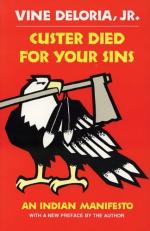
|
| Name: _________________________ | Period: ___________________ |
This test consists of 5 multiple choice questions, 5 short answer questions, and 10 short essay questions.
Multiple Choice Questions
1. What phrases does Mr. Farb continue to use when talking about Indians?
(a) Below standard.
(b) Inferior.
(c) Test tubes and living laboratories.
(d) Stupid and slow.
2. What did treaties initially do?
(a) They marked the boundaries between the lands of the Indian nations and the U.S.
(b) They helped establish state lines.
(c) They promised ownership of land that still belonged to the French.
(d) They divided the church territories.
3. What does not overlap across state boundaries?
(a) Water.
(b) Tribes.
(c) Buffalo.
(d) Treaty rights.
4. What French rationalist did the House Interior Committee use as a basis for their study of Indian Affairs?
(a) Blount Concur.
(b) Rene Descartes.
(c) Fred Callings.
(d) Mme. Frankser.
5. What is the main conflict of the Northwestern tribes and the government?
(a) Fishing and Gaming rights.
(b) Hunting and water rights.
(c) Herding rights.
(d) National Park rights.
Short Answer Questions
1. What did one anthropologist admit spending while studying a tribe of less than a 1,000 people?
2. What is the purpose of the Oklahoma Original Cherokee Community Organization?
3. Why are the Pyramid Lake Paiutes poor?
4. What kind of hats to anthropologists wear?
5. What did Lake Superior hold that the government wanted?
Short Essay Questions
1. What happened to the Seneca Nation of New York?
2. Why are hunting and fishing rights important to the Indians of Idaho, Washington and Oregon at the time of this writing?
3. Describe the treatment of the Choctaws. Why was their treatment worse when compared to other Indian peoples?
4. How does the author describe anthropologists? What is his attitude and tone when discussing this group of people?
5. According to the author, what European background is the law of the United States built on?
6. What is the problem with most books about American Indians, according to the author? What do the incorrect portrayals of the Indians do to harm the image of the Indian, and complicate understanding of the people by others?
7. Why are the American Indians lost when, in Congressional hearings, the chairman of the committee talks about the Anglo-Saxon heritage of law and order?
8. In February 1954, approval was granted for Termination of Indians. Why were the four factors, which Zimmerman implemented in 1947 to classify tribal readiness for termination, not used?
9. What is the Treaty of August 5, 1826 with the Chippewa tribe known for?
10. When the anthropologists stated that the Oglala Sioux need to be warriors, what was really happening to the Oglala Sioux?
|
This section contains 1,276 words (approx. 5 pages at 300 words per page) |

|




